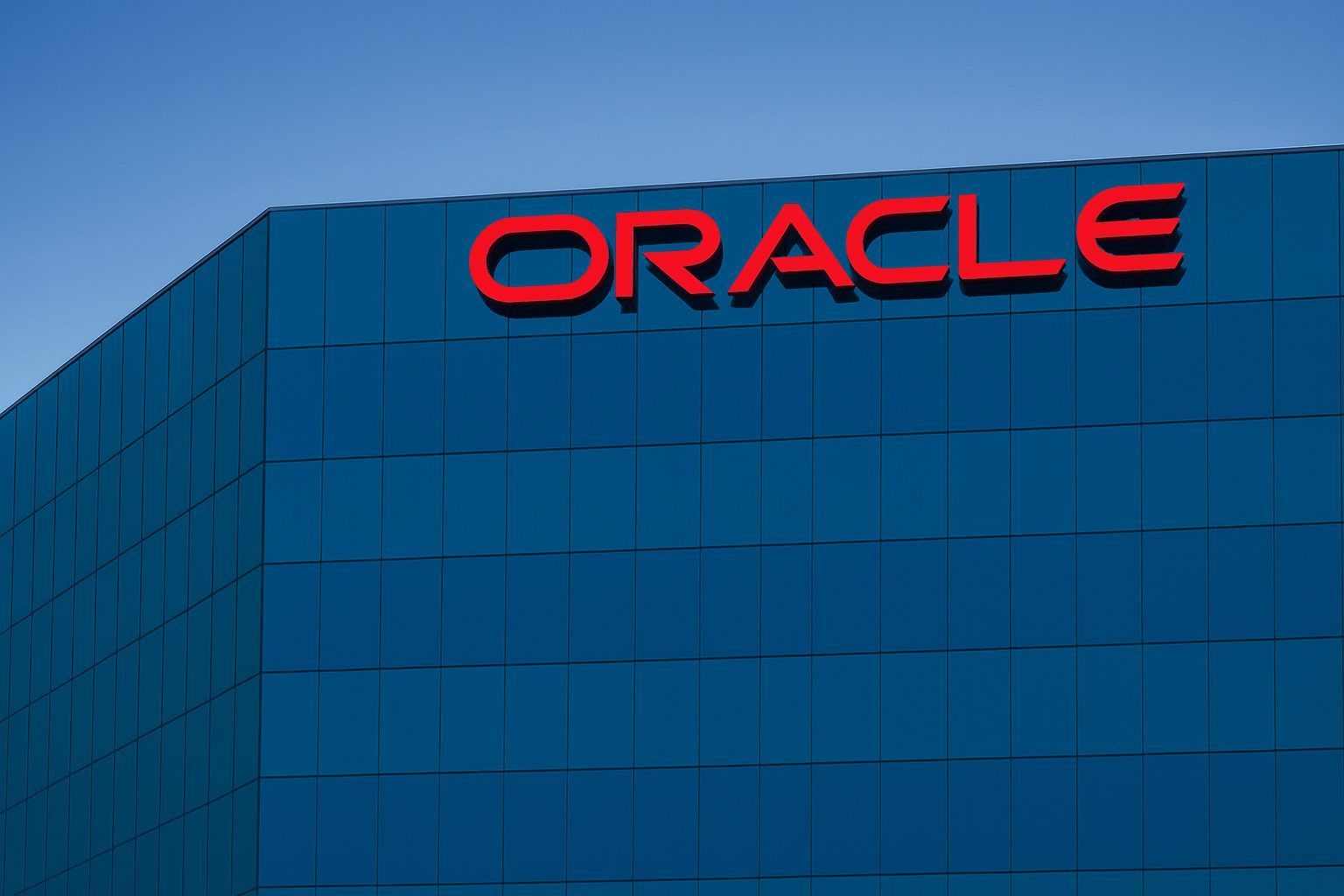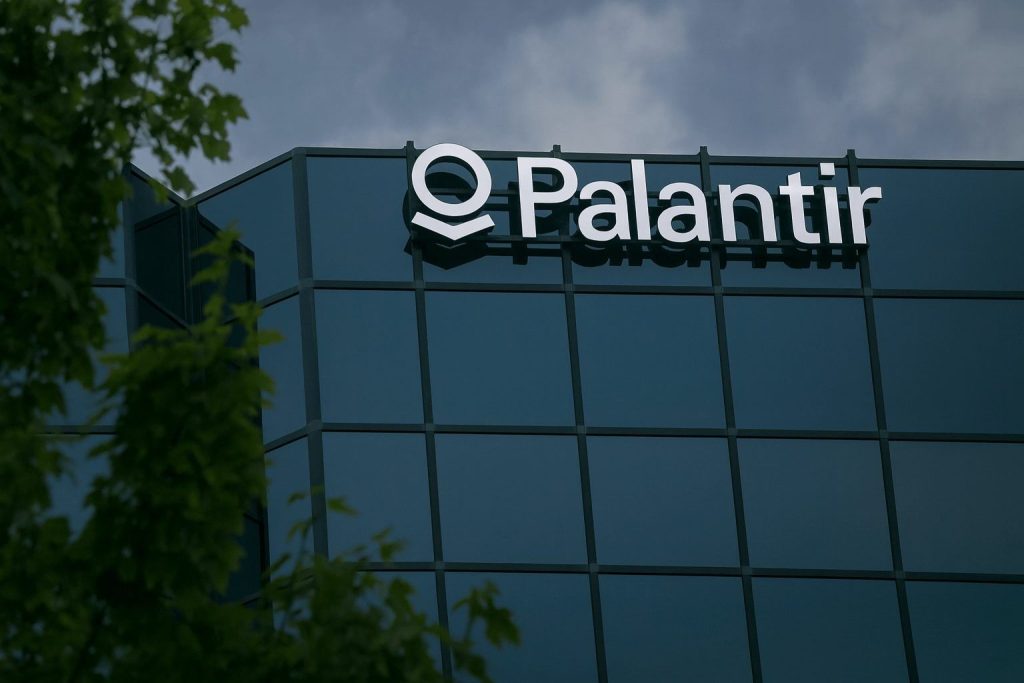Oracle Corporation (NYSE: ORCL) heads into Friday’s U.S. session as one of Wall Street’s most controversial AI plays. After soaring to record highs in September, the stock has since dropped more than 40% in two months, even as the company reports booming cloud and AI demand and a massive backlog of future revenue. [1]
At the same time, Oracle has become ground zero for growing fears about an “AI debt bubble” as it layers tens of billions of dollars of new borrowing on top of an already large balance sheet to fund huge data‑center projects and the ultra‑ambitious “Stargate” supercomputer partnership with OpenAI and SoftBank. [2]
Here’s what traders and longer‑term investors should know about Oracle stock before the market opens on Friday, November 28, 2025.
1. Where Oracle Stock Stands Right Now
- Last close (Nov 26, 2025): $204.96
- Move on Wednesday: +4.0% on heavy volume, bouncing from an intraday low near $196. [3]
- Market cap: about $584 billion.
- 52‑week range: $118.86 – $345.72, with shares now roughly 41% below their September record high but still more than 70% above their 52‑week low. [4]
From a valuation standpoint, Oracle still doesn’t look “cheap” in the classic sense:
- Trailing P/E: ~47x
- Forward P/E: ~26x
- Price‑to‑sales: ~9.9x
- Debt‑to‑equity: around 4.6x, reflecting very heavy leverage versus most mega‑cap tech peers. [5]
A Barchart analysis this week highlighted that Oracle is now underperforming the Dow Jones Industrial Average, largely because of its steep two‑month slide, even after Wednesday’s bounce. [6]
Takeaway for Friday: ORCL is coming into the session as a high‑beta, highly debated AI stock that has already corrected hard but still carries premium multiples and a very levered balance sheet.
2. Under the Hood: Cloud and AI Fundamentals Still Look Powerful
Despite the stock’s drawdown, Oracle’s reported fundamentals and AI positioning remain strong on several fronts.
Q1 FY2026: Explosive Cloud Backlog and OCI Guidance
In its fiscal Q1 2026 (reported September 9, 2025), Oracle:
- Grew total revenue 12% year‑over‑year to $14.93 billion.
- Reported cloud revenue of $7.19 billion, with cloud infrastructure (OCI) revenue up more than 50% year‑on‑year. [7]
- Saw remaining performance obligations (RPO) — its backlog of contracted revenue — jump 359% to $455 billion, driven by large AI and cloud deals. [8]
On the earnings call, Oracle guided that:
- OCI revenue is expected to grow 77% this fiscal year to around $18 billion, and
- Could reach roughly $144 billion over the subsequent four years, assuming its AI and multi‑cloud demand pipeline materializes. [9]
This guidance — and the backlog — is why bulls keep calling Oracle a core AI infrastructure stock, not just a legacy database vendor.
Multi‑Cloud Strategy: Deals With Microsoft, AWS and Google
Oracle has struck deep integration deals with all three hyperscale cloud rivals:
- Microsoft, via Oracle Database@Azure, lets customers run mission‑critical Oracle databases natively inside Azure regions while tapping Microsoft’s AI services. Microsoft and Oracle expanded features and regions in October 2025 and opened the door for partners to resell these joint solutions. [10]
- Oracle has similar OCI‑inside‑AWS and OCI‑inside‑Google Cloud arrangements, and reported that revenue from these hyperscaler partners grew more than 1,500% year‑over‑year in Q1. [11]
This “multi‑cloud everywhere” approach is central to Oracle’s pitch: it doesn’t need to beat Microsoft or Amazon outright; it wants to plug its databases and AI infrastructure into everyone else’s clouds.
AI Partnerships and Industry Momentum
Recent coverage has highlighted several AI‑driven wins for Oracle:
- Oracle joined Nvidia and AMD to provide AI supercomputers for U.S. national labs in a Department of Energy‑backed project, underscoring OCI’s role in cutting‑edge AI workloads. [12]
- Oracle Financial Services was named “Overall Winner” in the RiskTech AI 50 2025 ranking, reinforcing its reputation for using AI in financial risk and compliance software. [13]
- Oracle Communications’ 5G signaling core was chosen by NTT’s Transatel for IoT and connected‑vehicle services, signalling broader telco and IoT tailwinds for Oracle’s network and cloud stack. [14]
In a recent investor letter cited by Insider Monkey, growth manager Sands Capital described Oracle Cloud Infrastructure as evolving from a “second‑tier competitor” into a “preeminent infrastructure provider for some of the most significant AI companies,” thanks to its architecture and cost advantages. [15]
Takeaway for Friday: Fundamentally, Oracle is still posting double‑digit revenue growth, with rapidly expanding AI cloud revenues and a huge backlog — the bull case is very much alive.
3. Why Credit Markets Are Flashing Red on Oracle
The other side of the story — and the one dominating headlines this week — is debt.
Massive New Borrowing for AI and Data Centers
To fund its AI build‑out, Oracle has embarked on a borrowing spree:
- In September, Oracle issued $18 billion in U.S. investment‑grade bonds. [16]
- Separate reports say banks arranged around $18 billion in project financing for an AI‑focused data center complex in New Mexico, where Oracle will be the anchor tenant. [17]
- Another $38 billion loan package has been linked to data center projects in Texas and Wisconsin, developed by Vantage Data Centers for Oracle’s AI workloads. [18]
Analysts estimate that if all of these plans proceed, Oracle’s total debt could climb above $100 billion, cementing it as one of the most levered names in mega‑cap tech. [19]
Morgan Stanley’s “Short Oracle via CDS” Call
On Thursday, a detailed Morgan Stanley credit note ignited fresh worries:
- The bank’s credit analysts, Lindsay Tyler and David Hamburger, said five‑year credit default swaps (CDS) on Oracle — the cost of insuring its debt — have climbed to about 125 basis points, the highest level in three years. [20]
- They warned CDS spreads could move above 150 bps and potentially approach 200 bps next year — levels last seen around the 2008 financial crisis — if Oracle doesn’t better explain how it will fund its AI capex without straining its balance sheet. [21]
- Morgan Stanley now recommends investors go long Oracle CDS outright, calling the company the “weakest member of the AI hyperscaler herd” given its combination of heavy debt, large data‑center lease obligations and potential obsolescence risk. [22]
Oracle as a Gauge of the AI Debt Bubble
A broader Reuters and Bloomberg “Credit Weekly” analysis flagged Oracle as a key gauge of AI‑related market risk, noting that demand for credit protection has more than doubled the cost of credit derivatives on Oracle since September, as investors seek cover from a possible AI downturn. [23]
GuruFocus’ summary put it bluntly: Oracle’s debt‑risk indicators are at a three‑year high, and the company has “become a key indicator of AI risk in the credit market.” [24]
Takeaway for Friday: Watch credit headlines and CDS chatter as closely as the stock price — Oracle’s bond and derivatives markets are currently steering the narrative.
4. The Bear View: Oracle as AI Bubble “Poster Child”
Several recent pieces argue that Oracle has become a symbol of AI excess:
- A widely‑shared Investopedia article noted Oracle’s stock is down more than 40% from its September all‑time high, calling it a “poster child for growing investor concerns that an AI bubble has formed.” The article points to the company’s deep web of multi‑billion‑dollar deals tying together AI software makers, chip companies and cloud operators, raising fears about “circular” revenue flows and self‑dealing. [25]
- The same piece highlighted that Oracle’s overall debt surged above $100 billion after its recent bond deals and that a sizable chunk of its massive backlog appears tied to its partnership with OpenAI. [26]
- Reuters’ “Bubble Trouble” feature on November 21 pointed out that Oracle bonds sold off sharply after investors learned the company planned to increase its already large debt to fund AI infrastructure, and that lenders are now demanding greater protections across AI‑linked loans. [27]
- The Economic Times reported this week that Oracle stock has plunged about 30% in a month, calling out heavy debt and AI uncertainty as the main culprits and questioning whether the slide is a genuine “buy the dip” opportunity or a fresh warning sign. [28]
Other analysis from Trefis, Insider Monkey and others has similarly framed Oracle as a high‑beta proxy on the AI complex: when enthusiasm for AI infrastructure peaks, Oracle rips higher; when investors worry about over‑spending and funding, Oracle is often first to get hit. [29]
Bear checklist for Friday:
- Heavy leverage + rising interest costs.
- Potentially concentrated AI backlog exposure.
- Market increasingly sceptical about an AI bubble.
- CDS and bond yields saying “risk is going up, not down.”
5. The Bull Case: An “Oversold” AI Infrastructure Powerhouse?
The bears are loud — but they’re not alone.
Analysts Pushing Back on the Panic
On Wednesday, Oracle shares jumped more than 5% at the open after analysts at Deutsche Bank and HSBC publicly defended the stock:
- Deutsche Bank reiterated a Buy rating and a price target reportedly in the mid‑$300s, arguing that the recent sell‑off “over‑discounts” debt and capex risks while ignoring Oracle’s strong backlog and pricing power. [30]
- HSBC also reiterated Buy with a target in the $380 range, highlighting Oracle’s flexibility to modulate capital spending if markets tighten and its ability to turn backlog into high‑margin recurring revenue. [31]
GuruFocus summarized the mood in a headline: “Oracle Faces Brutal Spending Fears — Top Analyst Sees Explosive Upside.” [32]
Even after the drop, major Wall Street houses still carry targets well above the current price. A recent MarketBeat breakdown of analyst reports shows multiple firms with targets from $210 up to $400 and mostly neutral‑to‑outperform ratings, based on expectations that AI and cloud growth will drive double‑digit earnings expansion over the next several years. [33]
Fund Managers Still See Long‑Term Value
The Sands Capital investor letter highlighted Oracle as a top AI infrastructure holding, praising OCI’s rapid growth and framing the stock as a long‑duration compounder tethered to mission‑critical databases and ERP systems that are hard to rip out. [34]
A StocksToTrade analysis this week similarly pointed out that:
- Oracle’s revenue has climbed to around $57 billion annually,
- Gross margins remain high (mid‑60s), and
- Its AI supercomputer and financial‑services AI wins showcase a business that may still be in the early innings of monetizing its spending binge. [35]
Many bulls argue that AI infrastructure is a “build now, profit later” story — and that Oracle’s current multiples are not unreasonable if its OCI growth and multi‑cloud opportunities play out anywhere near management’s guidance.
“Oversold” Technicals
A Yahoo Finance segment titled “Oracle is ‘oversold’: The bull case to buy the dip” this week emphasized:
- ORCL is down roughly 30% in the past month,
- The 14‑day RSI on Finviz sits in the low‑30s (oversold territory), and
- Much of the debt/capex worry may already be in the price if Oracle executes and clarifies its funding plan. [36]
Bull checklist for Friday:
- Deep backlog and accelerating cloud/AI revenue.
- Multi‑cloud scale‑up with all major hyperscalers.
- Powerful installed base in databases and ERP.
- Analyst and institutional support that sees the sell‑off as overdone.
6. What Options and Short Interest Say About Sentiment
Beyond the stock and bonds, derivatives and positioning offer clues about how investors are bracing for Oracle’s next move.
Short Interest: Rising, But Not Extreme
MarketBeat data shows:
- About 1.45% of Oracle’s float is sold short,
- Short interest rose roughly 18% over the past month, but
- The days‑to‑cover ratio remains just over 1 day, implying shorts could cover relatively quickly on a strong rebound. [37]
So while bearish bets have picked up, this is not (yet) a heavily shorted meme‑style situation — it’s more like a crowded hedge than an outright “everyone’s betting on a collapse” scenario.
Deep Out‑of‑the‑Money Puts: Big Hedge or Big Bet?
A Barchart‑sourced report highlighted unusually large trades in long‑dated, deep out‑of‑the‑money put options on ORCL:
- These puts expire more than a year from now.
- They only really pay off if Oracle stock falls roughly 50% from current levels. [38]
The article notes that such trades often reflect institutional hedging rather than a pure directional bet — but their size underscores how some investors are preparing for a worst‑case credit or AI‑bubble scenario, even as others see the same downside levels as proof of Oracle’s “underlying value.”
Takeaway for Friday: Expect options‑driven volatility to remain high; liquidity is good, but positioning is polarized.
7. Ownership, Insider Activity and Boardroom Moves
Institutional and Insider Ownership
According to a November 27 MarketBeat report:
- Korea Investment Corp trimmed its Oracle position by about 4.2% in Q2, selling 55,050 shares but still holding roughly 1.27 million shares worth $276.6 million — about 0.6% of its portfolio. [39]
- Overall, roughly 42–45% of Oracle’s shares are held by institutions and funds, while corporate insiders (including Larry Ellison) still own around 41% of the stock, a very high insider stake for a mega‑cap. [40]
Insider filings show:
- Executive Michael Sicilia and director Jeffrey Berg both sold sizeable chunks of stock in September and October at prices north of $280–320, part of more than 200,000 shares sold by insiders over the past 90 days. [41]
Those sales occurred near the top and will likely continue to be cited by bears as evidence insiders took advantage of the pre‑correction AI euphoria.
New Independent Director
On November 20, 2025, Oracle appointed Stephen Rusckowski, former CEO of Quest Diagnostics, to its board. The company highlighted his experience in healthcare, diagnostics and data analytics as helpful for Oracle’s cloud and industry‑vertical strategies. [42]
While this doesn’t directly move the stock short‑term, it adds another seasoned operator to a board that will be navigating high‑stakes decisions on AI spending, leverage and risk management.
8. Key Events and Metrics to Watch Beyond November 28
Next Earnings Date (Q2 FY2026)
Oracle has not yet officially announced the date for its fiscal Q2 2026 earnings release. Third‑party earnings calendars currently estimate an early‑to‑mid‑December date, with several services pointing to the December 8–14, 2025 window, based on past reporting patterns. [43]
Investors will be laser‑focused on:
- Updated AI and OCI guidance — does Oracle maintain, raise or trim its aggressive targets?
- Free cash flow and capex — can the company better align spending and cash generation?
- Debt and interest expense — clarity on how much more borrowing is actually coming.
- Details on major AI projects, especially the OpenAI/SoftBank “Stargate” build‑out and the economics of its multi‑cloud deals. [44]
Macro and Sector Context
Broader AI and credit headlines will also matter:
- Reuters has noted that AI hyperscalers (Alphabet, Meta, Oracle, Amazon) have issued nearly $90 billion in public bonds since September, increasing worries that AI capex is being financed more by debt than cash flows. [45]
- If more stories emerge about AI bond jitters or if other tech giants’ CDS spreads blow out, Oracle is likely to remain the market’s preferred hedge against AI excess.
9. Oracle Stock: Practical Checklist Before Friday’s Open
For traders and investors looking at ORCL before the bell on November 28, 2025, here’s a concise checklist:
- Price Levels & Volatility
- Watch whether ORCL holds above the $200 area, which has acted as a key psychological level in recent sessions. A decisive move below could invite another wave of technical selling; a sustained hold above it would support the “wash‑out is behind us” view. [46]
- Fresh Credit‑Market Headlines
- Any new commentary on Oracle’s CDS spreads, bond yields or data‑center financing — especially from rating agencies or large banks — could move the stock pre‑market. Morgan Stanley’s call has made credit the main storyline. [47]
- Analyst Notes and Target Changes
- Follow‑up notes from Deutsche Bank, HSBC or other brokers either reinforcing or walking back their bullish stance could drive another gap move, as we saw on Wednesday. [48]
- Options and Flow
- Large new put or call blocks — especially in long‑dated strikes — may signal how institutional desks are positioning into December earnings and the AI debt narrative. [49]
- Peers and AI Sentiment
- Moves in Nvidia, Microsoft, Alphabet, Meta and SoftBank will color sentiment. Oracle is now seen as a barometer for AI funding risk: if AI heavyweights sell off on renewed bubble concerns, ORCL often trades worse. [50]
- Any New Details on “Stargate” or Data‑Center Plans
- Fresh disclosures — whether from Oracle, OpenAI, SoftBank or regulators — about the scale, timing or structure of the Stargate supercomputer project or related data‑center financing could either calm or heighten funding fears. [51]
- Macro Tape
- With AI debt now framed as a potential systemic risk for credit markets, any macro stress (wider credit spreads, weak economic data, rate repricing) could disproportionately pressure Oracle versus software names with lighter balance sheets. [52]
Final Word: High Reward, High Complexity, High Controversy
Heading into the November 28 open, Oracle stock sits at the intersection of three powerful forces:
- A genuinely strong AI and cloud growth story, backed by huge RPO and multi‑cloud partnerships.
- A very real balance‑sheet and funding debate, with some of Wall Street’s most sophisticated credit desks now using Oracle CDS to hedge AI risk.
- A broader AI sentiment swing, as markets decide whether this year’s AI spending boom is the start of a long‑run transformation or the front edge of a bubble.
For news readers and investors alike, ORCL is likely to remain a headline stock in coming weeks — both on the way down if debt fears intensify, and on the way up if the company can convince markets that its AI bet will generate enough durable cash flow to pay for the bill it’s running up.
This article is for informational purposes only and does not constitute investment advice. Always do your own research or consult a licensed financial adviser before making trading or investment decisions.
References
1. finviz.com, 2. www.investopedia.com, 3. finviz.com, 4. finviz.com, 5. finviz.com, 6. www.barchart.com, 7. investor.oracle.com, 8. www.reuters.com, 9. www.reuters.com, 10. www.oracle.com, 11. www.reuters.com, 12. stockstotrade.com, 13. stockstotrade.com, 14. stockstotrade.com, 15. finviz.com, 16. www.gurufocus.com, 17. www.gurufocus.com, 18. www.gurufocus.com, 19. www.investopedia.com, 20. www.gurufocus.com, 21. www.ft.com, 22. www.ft.com, 23. www.reuters.com, 24. www.gurufocus.com, 25. www.investopedia.com, 26. www.investopedia.com, 27. www.reuters.com, 28. m.economictimes.com, 29. finance.yahoo.com, 30. finviz.com, 31. finviz.com, 32. www.etoro.com, 33. www.marketbeat.com, 34. finviz.com, 35. stockstotrade.com, 36. finviz.com, 37. www.marketbeat.com, 38. www.inkl.com, 39. www.marketbeat.com, 40. www.marketbeat.com, 41. www.marketbeat.com, 42. investor.oracle.com, 43. www.nasdaq.com, 44. www.investopedia.com, 45. finance.yahoo.com, 46. www.fxleaders.com, 47. www.ft.com, 48. www.investing.com, 49. www.inkl.com, 50. www.reuters.com, 51. www.investopedia.com, 52. finance.yahoo.com









